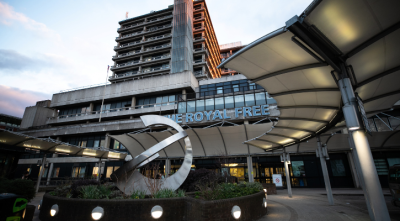The vascular studies department sees both adult and paediatric patients being cared for by a range of specialties on an inpatient and outpatient basis.
It forms part of the trust’s diagnostic framework, monitoring of patients on aneurysm, deep vein thrombosis, varicose vein, stroke, claudication, serious limb ischaemia, vascular malformations and anomalies, giant cell arteritis, thoracic outlet syndrome, or dialysis access pathways.
The department is actively engaged in research and education and provides the trust’s Doppler ultrasound examination service.
What are Doppler ultrasounds?
Doppler ultrasound scans, sometimes known as duplex scanning, are safe and non-invasive, and are used to specifically investigate the peripheral vascular system for venous or arterial disease (the arteries and veins in the arms, legs, neck and abdomen).
Referrals from primary care clinicians within north central London (NCL) are accepted for patients with suspected acute lower limb deep vein thrombosis using the pathway and process found on the NCL Integrated Care Board website.
Referrals from primary care for other tests are not currently accepted, as typically patients on pathways for these conditions are better served by referral directly to the appropriate secondary care specialty.
Referrals from Royal Free London clinicians can be made using the NHS e-Referral Service.
If you have an appointment scheduled with the vascular studies team, then it is likely to be for one or more of the following investigations:
- ankle brachial pressure indices (ABPI)
- exercise ABPI (treadmill exercise test)
- toe pressures
- carotid doppler (neck scan)
- lower limb arterial/venous duplex (leg scan)
- upper limb arterial/venous scan (arm scan)
- peripheral bypass graft surveillance
- abdominal aortic aneurysm (AAA) scan
- endovascular aneurysm repair (EVAR) surveillance
- haemodialysis access graft duplex
Your appointment
Upon arrival, you will be greeted by one of the team and directed to the waiting area.
The investigation itself will be performed by a vascular scientist or an associate practitioner, who will explain the procedure and address any queries you may have before the test.
Typically, you will need to remove items of clothing to allow the application of a small quantity of a water-based gel on the skin's surface of the area being examined. This allows the ultrasound scanner to generate a live visualisation of the circulation.
During the test, you may hear sounds coming from the machine which relate to the sound of the blood flowing through the body.
Vascular ultrasound investigations are safe, non-invasive, and painless.
The duration of the appointment can vary significantly depending on the type and number of scans required, although typically it ranges from 20 to 45 minutes.
 Translate
Translate



